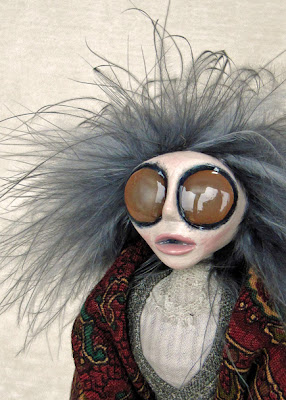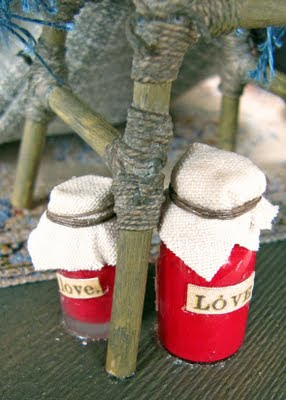I've had a bit of a problem with my back for years now. And last week it decided without my say so to have a bit of an "Episode". So I had to stay home from work at the day job.
To keep myself occupied I sat in my comphy upright chair, stayed warm, took my tablets, watched hours of period dramas, and sewed until my fingers hurt. Not only did I manage to finish my Maria Manning doll, but also managed to get my mothers Christmas present, a Spanish Flamenco Dancer doll, dressed and wigged. So here they both are.
Maria Manning was born in Switzerland and emigrated to Britain to work as a lady’s maid to the wealthy Lady Blantyre, who was the daughter of the Duchess of Sutherland. She developed a taste for a luxurious lifestyle amid the elegance of her employer’s homes and general finery. She dreaded the idea of poverty, and resolved she would never live like that. She met Patrick O’Connor while travelling with her mistress. And as a custom-house officer at London’s docks he was independently wealthy, as well as his being a well-known money lender. Maria was also involved with Frederick Manning, who did not have a very well paid job. Both men proposed to her at around the same time, and Maria had to decide which one of them would make the better husband and provide for her better. After promising Maria that he was soon to come into a large inheritance, the younger Frederick ‘won the day’, and he and Maria were married. At first the couple afforded a fairly stylish house, but she soon realised that the inheritance was not to come. She continued to see O’Connor, and renewed her affair with him; apparently with the acquiescence of Manning.
On 17th Aug 1849 two policemen discovered a body under the flagstones in the kitchen of Mr & Mrs Manning’s home in Bermondsey. The skull was fractured in two places, and a bullet protruded under the skin of the right eye. The deceased was Patrick O’Connor who had been a frequent visitor to the house, and had often joined the couple for dinner at their home. Maria had hatched a plan to kill her rich lover and take his money. It’s known that she purchased a sack of quicklime and a shovel before inviting him to dinner on the 9th Aug 1849. When he arrived she suggested that he might like to wash his hands before dinner. And as he did so standing at the kitchen sink, she shot him in the head with a pistol. The bullet did not kill him, and Frederick finished him off by battering his head with a crowbar. The couple then buried the body in a pre-dug grave below the kitchen flagstones, covering it with plenty of quicklime to try and speed the body’s decay. The following day Maria went to O’Connor’s lodgings and managed to con her way into his rooms where she systematically went through his belongings and stole railway shares and other valuables, returning the next day to take anything more she had missed. She was the power behind the murder, although her husband had helped.
Two days later two men claiming to be O’Connor’s colleagues came to the Manning home looking for him, giving them a nasty fright. They suspected that they were detectives, and so decided to leave London immediately. After sending her husband to try and sell their furniture Maria packed everything of value she could find and that she could carry and left for Edinburgh. Maria’s motive was pure greed, and while she was willing to grant O’Connor sexual favours it’s clear all she really wanted was his money. Mrs Manning was eventually found and arrested in Edinburgh, where she was trying to sell the railway shares she had stolen from the murdered man. Her husband was found in Jersey. The contrast between Maria and her husband was great, her with a proud, cold demeanour and he unimpressive and weak, which left him widely despised for hiding behind his wife.
At their trial each tried to blame the other, and as the verdict was passed Maria showed the only emotion that she had shown throughout the whole of her arrest, trial and finally her execution – She lost her composure and screamed and raved at the judge, shouting “Damnation Seize Ye All” as he tried to pass the death sentence. Although she apparently asked the wardens escorting her back to gaol how they had liked her performance in court. She was considered a suicide risk, and had 3 wardenesses that slept in the cell with her, very much to her disgust. She lulled them into a false sense of security, and after letting her nails grow long tried to strangle herself and puncture her own windpipe. To prepare her for the gallows her arms where bound behind her with cords, and her stiff starched and corded petticoats would have been taken away so that her gown and legs could be bound on the platform to prevent the wind causing her skirts to blow up. She asked to be blindfolded by a black silk handkerchief, and had her face covered with a black lace veil to conceal her features from public gaze. Walking to their death at a public hanging she walked to her doom with a firm, unfaltering step, while his step was ‘feeble and tottering, and he had to be supported by two turnkeys’. On their way a singular coincidence occurred. The Manning’s walked over their own graves, just as they had made their victim do in the kitchen.
Maria Manning made it into Madame Tussaud’s famous waxworks. And it’s likely that they were sold the actual dress that Maria had died in. She was an attractive woman. Her gown as she walked to her death was of black satin, and it was widely believed that it was because of this that black satin became unfashionable immediately after her execution and stayed so for nearly 30 years.
Charles Dickens described the sight of the hangings – “The man’s a limp loose suit of clothes, as if the man had gone out of them; the woman’s a fine shape, so elaborately corseted and artfully dressed, that it was quite unchanged in its trim appearance as it swayed slowly from side to side”.
My Maria wears white cotton bloomers and shift under a corset and lots of petticoats. Over her sage green under petticoat she has one with lots of cording sewn tightly tucked inside by hand to help hold out her huge skirts. This was before the introduction of the cage crinoline, and skirts were held out with as many petticoats as a woman could bear to wear or carry, sometimes as many as 20 plus layers of petticoats, all sewn to one or two waistbands, using different techniques to stiffen them and lots and lots of starch. After this corded petticoat (which actually lets this doll stand unaided if you get the balance right), Maria has a heavily flounced dark red petticoat before her black satin under- and over-skirts. She has a black lace shoulder covering small shawl and false sleeves, and a black satin bodice with fashionable almost off the shoulder low arm seemed shoulders. The sash she wears around her waist is purple satin, and her hair had a touch of navy blue to add some colour. A lady at this time would not have gone out in public without a bonnet or hat. And there are illustrations that picture Maria in a white cap trimmed with black lace. So I made my doll a similar cap of ivory silk cotton and trimmed it with black satin ribbon and lace. And I've made her her own rope noose to carry to the gallows.
After all that darkness it was a real change to sew the bright red spotted cotton into loads of ruffles for my Mother's Rosy, a traditional Flanenco Dancer with a fitted long bodice, ruffles at her neck, sleeves, wrists and all over her trailing skirt, with a white lace shawl for good measure. She was fun to make, even though not really my style. And I really hope my Mam likes her :)




























